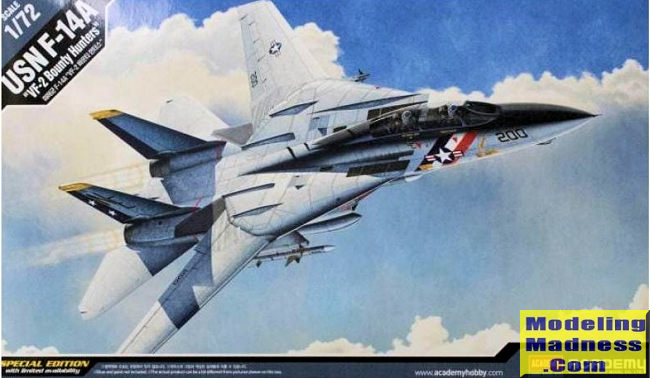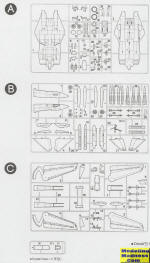
Academy 1/72 F-14A "VF-2 Bounty Hunters"
| KIT #: | 12532 |
| PRICE: | $24.68 |
| DECALS: | Two options |
| REVIEWER: | Scott Van Aken |
| NOTES: |
2016 boxing. |

| HISTORY |
The Grumman F-14 Tomcat is a supersonic, twin-engine, two-seat, variable-sweep wing fighter aircraft. The Tomcat was developed for the United States Navy's Naval Fighter Experimental (VFX) program following the collapse of the F-111B project. The F-14 was the first of the American teen-series fighters, which were designed incorporating the experience of air combat against MiG fighters during the Vietnam War.
The F-14 first flew in December 1970 and made its first deployment in 1974 with the U.S. Navy aboard USS Enterprise (CVN-65), replacing the McDonnell Douglas F-4 Phantom II. The F-14 served as the U.S. Navy's primary maritime air superiority fighter, fleet defense interceptor and tactical aerial reconnaissance platform. In the 1990s, it added the Low Altitude Navigation and Targeting Infrared for Night (LANTIRN) pod system and began performing precision ground-attack missions.
In the 1980s F-14s were used as land-based interceptors by the Islamic Republic of Iran Air Force during the Iran–Iraq War, where they saw combat against Iraqi warplanes. Iranian F-14s reportedly shot down at least 160 Iraqi aircraft during the war, while only 12 to 16 Tomcats were lost; at least half of these losses were due to accidents.
The Tomcat was retired from the U.S. Navy's active fleet on 22 September 2006, having been supplanted by the Boeing F/A-18E/F Super Hornet. The F-14 remains in service with the Islamic Republic of Iran Air Force, having been exported to Iran in 1976, when the U.S. had amicable diplomatic relations with Iran. Thanks to help from Israel and a growingly competent local aviation industry, the IRIAF has been able to keep these planes in service.
| THE KIT |
 Academy
has produced several boxings of this kit, all of which appear to be the same except for markings. One does have to be careful with Tomcat kits and markings as there were subtle changes in the area around the gun and the very rear of the aircraft. Specifically the gun gas vents and the beavertail. The vents on this kit are the ones provided During the middle/later years of the aircraft's usage. Early Tomcats had a design that was seven equally sized rectangles and many of those that lasted until the end had this changed to NACA
ducts. A modeler who cares about this sort of thing will check reference photos.
This kit also has the reinforcements on the upper fin that one has to consider.
These are simply engraved rather than properly raised so can be f
Academy
has produced several boxings of this kit, all of which appear to be the same except for markings. One does have to be careful with Tomcat kits and markings as there were subtle changes in the area around the gun and the very rear of the aircraft. Specifically the gun gas vents and the beavertail. The vents on this kit are the ones provided During the middle/later years of the aircraft's usage. Early Tomcats had a design that was seven equally sized rectangles and many of those that lasted until the end had this changed to NACA
ducts. A modeler who cares about this sort of thing will check reference photos.
This kit also has the reinforcements on the upper fin that one has to consider.
These are simply engraved rather than properly raised so can be f
Each of the wings is an upper and lower half
The bi
Instructions are well done with mul
| CONCLUSIONS |
As with any kit, only building it will really tell the full story. I've seen kits beautifully molded that were the pits to build and others that went together like a dream. My experience with Academy kits has generally been quite positive so we'll see how this one goes.
| REFERENCES |
http://en.wikipedia.org/wiki/F-14_Tomcat
January 2019
Copyright ModelingMadness.com. All rights reserved. If you would like your product reviewed fairly and fairly quickly, please
contact
the editor
or see other details in the
Note to
Contributors.
Back to the Main Page
Back to the Review
Index Page
Back to the Previews Index Page